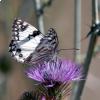E' una delle farfalle più interessanti ed eleganti, endemica dell'Italia centro-meridionale, vive solo in praterie aride e calde su suoli calcarei, e vola negli ultimi dieci giorni di maggio, fino ai primi di giugno. Si trova in ampie aree del salernitano e della Regione Campania.
E' una specie legata a formazioni steppiche aride con rocce affioranti, cespugli sparsi e alberi radi. Si vede sfarfallare prevalentemente nei fondovalle riparati da vento o in aree collinari interne. Il range altitudinale è ampio, può infatti trovarsi dal livello del mare fino a circa 1500 metri di quota. Le larve si sviluppano a spese di varie specie di graminacee. Gli adulti sono attivi tra maggio e giugno.
La colorazione bianca costituiscono un elemento che ne permette il riconoscimento. Sulle ali anteriori è presente un ocello (disegni circolari presenti sulle ali) di colore azzurro cerchiato di nero. La specie è protetta dalla Direttiva europea Habitat ed è minacciata dalle modificazioni degli ambienti naturali come gli incendi ed il pascolo eccessivo. Per poter conservare le farfalle in tutta la loro molteplicità è necessaria la conservazione degli elementi paesaggistici incontaminati e ancora esistenti come pendii aridi, brughiere, cespugli. è

The Italian marbled white Melanargia Arge is one of the most interesting and elegant species of butterflies. It is an endemic species found only in the southern half of Italy and the eastern half of Sicily. Lives only in dry and warm grazing lands, and flies from the ten last days of March until the first days of June. This butterfly is found in the wide areas of province of Salerno and in the Campania Region.
This species is closely related to be found in dry steppe with emerged rocks, spreaded bushes and trimmed trees. It is observed flying mainly in the valley floors where founds protection from the wind or in inland hills. In its immature, wingless stage the butterfly grows at the expense of various species of oat grass. The action of the fully-grown insect takes place from May to June.
Its identification is easily made by the white colored wings, while in the front part exists a circular, eye-shaped, design of light blue color encircled by black details. This species is protected by The Habitats Directive of European Commission because is endangered from the changing climate factors such as conflagrations and the excessive pasture. For the protection of this particular species it is necessary to maintain the existence of the uncontaminated landscapes such as dried, grassy and bushy areas.






